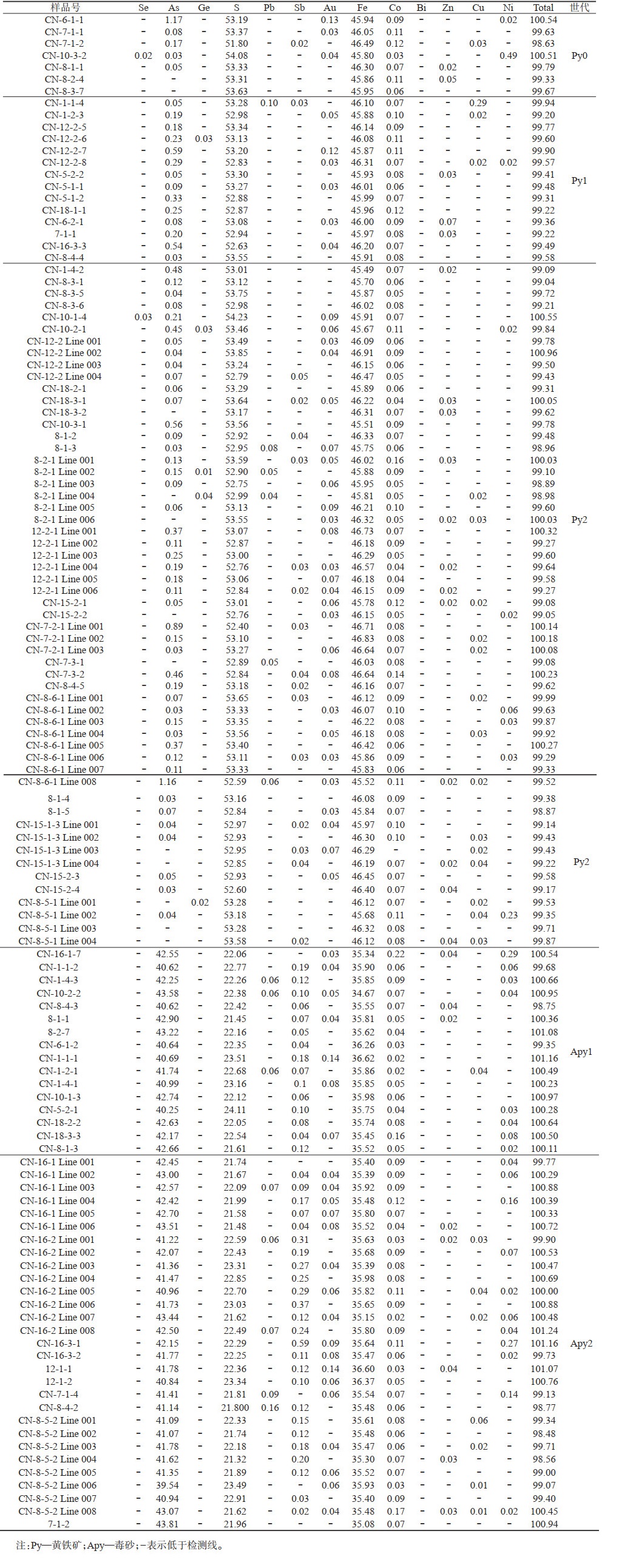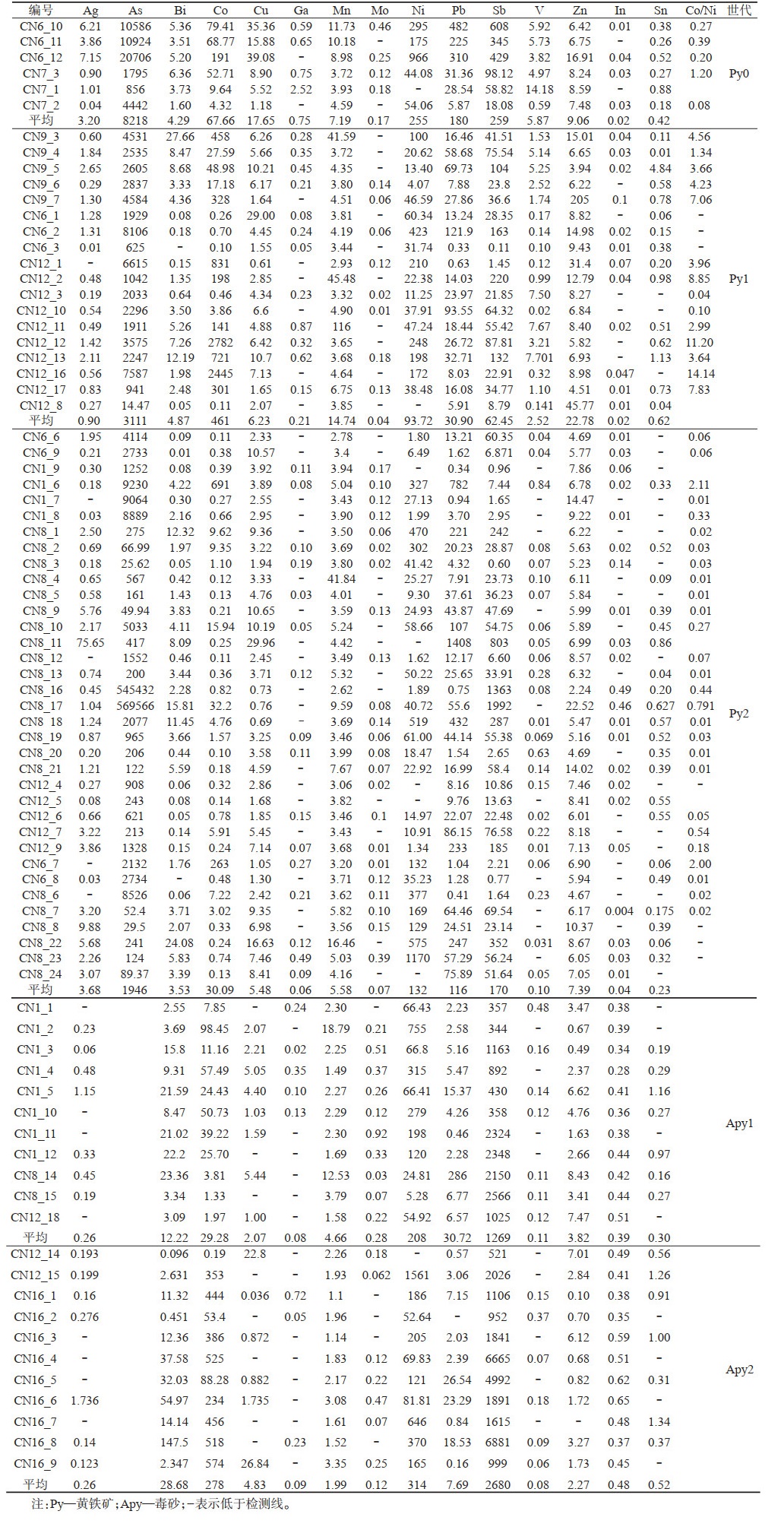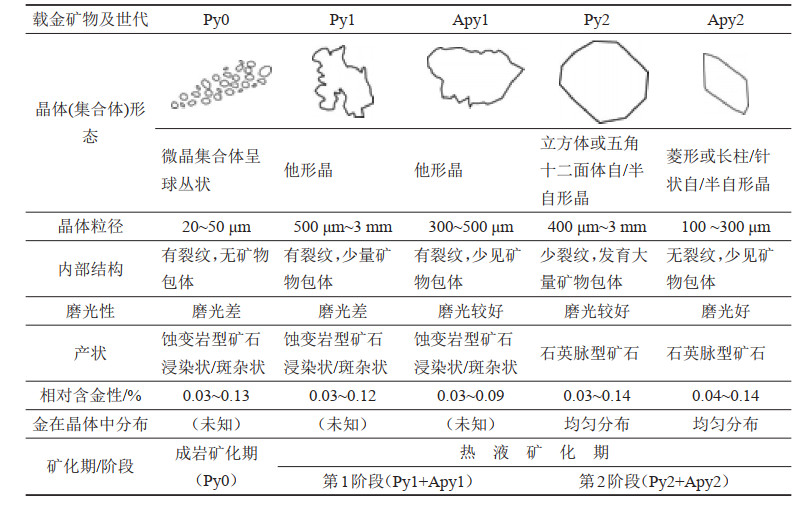The ore-forming process of the Sawayaerdun gold deposit, western Tianshan, Xinjiang: Contraints from the generation relationship and EMPA, LA-ICP-MS and FESEM analysis of the Pyrite and Arsenopyrite
-
摘要:
研究目的 为确定硫化物中金的赋存状态及元素含量特征。
研究方法 本文选取西天山萨瓦亚尔顿造山型金矿床(探明金储量127 t,远景资源量350 t),针对矿石矿物黄铁矿、毒砂开展系统显微岩/矿相学观测、电子探针、LA-ICP-MS和扫描电镜分析。
研究结果 结果表明萨瓦亚尔顿矿石中除可见金外,还有"不可见金"主要以固溶体(Au+)形式赋存于黄铁矿、毒砂中。矿石中载金黄铁矿发育3期:球丛状黄铁矿(Py0)呈浸染状分布于围岩中,局部富含金,同时富集Ag、As、Bi、Ni、Cu、Pb、Sb等微量元素;他形黄铁矿(Py1),分布于硅化围岩及强烈变形石英脉中,与他形毒砂(Apy1)伴生,电子探针得到的平均金含量为0.050%,富集Co、Mn、Zn等微量元素;自形-半自形黄铁矿(Py2),在矿体中分布最为广泛,与未变形石英脉密切共生,伴生自形毒砂(Apy2),电子探针分析得到的平均金含量为0.052%,微量元素相对Py1、Py2较为亏损。
结论 推测Py0形成于沉积成岩期;Py1形成于同碰撞期,与塔里木板块与中天山地块在晚石炭世碰撞事件有关;Py2形成于晚/后碰撞阶段。赋矿地层可能是金的初始矿源层,同时提供了部分微量元素,地层变质脱水作用形成的变质流体是主要的成矿流体。研究表明萨瓦亚尔顿金矿发育多期成矿作用,相似成矿过程在西天山同类型矿床中可能也有发生。
Abstract:This paper is the result of mineral exploration engineering.
Objective To determine the occurrence of Au and elements feature of the sulfide.
Methods The Sawayaerdun orogenic gold deposit (explored Au: 127 t, prospective Au: 350 t) in the western Tianshan is chosen and the microscopic petrography study, EMPA, LA-ICP-MS and FESEM analysis have been applied.
Results Except for "visible gold", the result indicate that "invisible gold" is likely present as solid soluation (Au+) in the pyrite and arsenopyrite in the Sawayaerdun deposit. Three generations of auriferous pyrite have been recognized. The pyrite with framboidal texture (Py0) are disseminated in the host rock, and are locally enriched in gold. They have relatively high values of Ag、As、Bi、Ni、Cu、Pb、Sb. The anhedral pyrite (Py1), associated with silicified rocks and quartz veins that experienced strong deformation, have an average Au content of 0.050%. They have high contents of Co、Mn、Zn. The euhedral-subhedral pyrite (Py2) are best developed in the main orebodies, and have an average Au content of 0.052%. Comparing to Py1, Py2, they have lower contents of trace elements.
Conclusions The Py0 are interpreted to have formed contemporaneously with the ore-bearing rocks. Py1 are interpreted to have formed in the syn-tectonic stage, during the collision between the Tarim craton and the Central Tianshan terrane in the Late Carboniferous, whereas Py2 were formed in a later mineralization event, during the late- to post-tectonic stage in the Early Permian. Ore-bearing strata could be the initial source bed of gold, meantime provides the trace elements when forming gold-bearing sulfides. The ore-forming fluids were probably metamorphic fluids deriving from dehydration of the sedimentary strata. The study results suggest that multi-stage of gold mineralization have developed in the Sawayaerdun deposit, similar metallogenic process may exist in other homogeneous deposits in the Western Tianshan Orogen.
-

-
图 1 萨瓦亚尔顿地区区域地质简图(据陈华勇等,2013修编)
Figure 1.
表 1 萨瓦亚尔顿金矿黄铁矿、毒砂电子探针成分分析结果(%)
Table 1. EMPA analytical results of pyrite and arsenopyrite in Sawayaerdun gold deposit(%)

表 2 萨瓦亚尔顿金矿黄铁矿、毒砂LA-ICP-MS分析结果(10-6)
Table 2. LA-ICP-MS analytical results of pyrite and arsenopyrite in Sawayaerdun gold deposit(10-6)

表 3 萨瓦亚尔顿金矿床黄铁矿、毒砂主要特征
Table 3. The main characteristics of pyrite and arsenopyrite in the Sawayaerdun gold deposit

-
Bralia A, Sabatini G, Troja F. 1979. A revaluation of the Co/Ni ratio in pyrite as geochemical tool in ore genesis problems: Evidences from southern Tuscany pyritic deposits[J]. Miner. Deposita, 14: 353-374. https://link.springer.com/article/10.1007/BF00206365
Chen Fuwen, Li Huaqin. 2003. Metallogenic chronology of the Sawayaerdun gold-antimony deposit in Xinjiang[J]. Acta Geoscientica Sinica, 24(6): 563-567(in Chinese with English abstract).
Chen H Y, Chen Y J, Baker M. 2012a. Evolution of ore-forming fluids in the Sawayaerdun gold deposit in the Southwestern Chinese Tianshan metallogenic belt, Northwest China[J]. Journal of Asian Earth Sciences, 49: 131-144. doi: 10.1016/j.jseaes.2011.05.011
Chen H Y, Chen Y J, Baker M. 2012b. Isotopic geochemistry of the Sawayaerdun orogenic-type gold deposit, Tianshan, northwest China: Implications for ore genesis and mineral exploration[J]. Chemical Geology, 310: 1-11. https://www.sciencedirect.com/science/article/pii/S0009254112001519
Chen Huayong, Chen Yanjing, Ni Pei, Zhang Li, Zhang Zengjie. 2007. Chemical composition of fluid inclusions of the Sawayaerdun gold deposit, Xinjiang: Implications for oregenesis and prediction[J]. Acta Petrologica Sinica, 23(9): 2189-2197(in Chinese with English abstract).
Chen Huayong, Zhang Li, Li Dengfeng, Zhang Zengjie. 2013. Characteristics of rare earth and trace elements of the Sawayaerdun gold deposit, Southwest Tianshan: Implications for ore genesis[J]. Acta Petrologica Sinica, 29(1): 159-166(in Chinese with English abstract).
Chen Maohong, Mao Jingwen, Chen Zhenyu, Zhang Wei. 2009. Mineralogy of arsenian pyrites and arsenopyrites of Carlin-type gold deposits in Yunnan-Guizhou-Guangxi "golden triangle" area, southwestern China[J]. Mineral Deposits, 28(5): 539-557(in Chinese with English abstract).
Cook N J, Ciobanu C L, Mao J. 2009. Textural control on gold distribution in As-free pyrite from the Dongping, Huangtuliang and Hougou gold deposits, North China Craton (Hebei Province, China)[J]. Chemical Geology, 264(1/4): 101-121. https://www.sciencedirect.com/science/article/pii/S0009254109001065
Cook N J, Ciobanu L R, Meria D, Silcock D, Wade B. 2013. Arsenopyrite-pyrite association in an orogenic gold ore: Tracing mineralization history from textures and trace elements[J]. Economic Geology, 188(6): 1273-1283. https://pubs.geoscienceworld.org/georef/record/6/3531030/Arsenopyrite-pyrite-association-in-an-orogenic
Deditius A P, Utsunomiya S, Renock D, Ewing R C, Ramana C V, Becker U, Kesler S E. 2008. A proposed new type of arsenian pyrite: composition, nanostructure and geological significance[J]. Geochimica et Cosmochimica Acta, 72(12): 2919-2933. doi: 10.1016/j.gca.2008.03.014
Fleet M E, M umin A H. 1997. Gold-bearing arsenian pyrite and marcasite from Carlin trend deposits and laboratory synthesis[J]. American Mineralogist, 82(1): 182-193. https://pubs.geoscienceworld.org/msa/ammin/article-abstract/82/1-2/182/43243/Gold-bearing-arsenian-pyrite-and-marcasite-and
Fu Shaohong, Gu Xuexiang, Wang Qian, Xia Yong, Zhang Xingchun, Tao Yan. 2004. The typomorphic characteristics of gold bearing pyrites from Shuiyindong gold deposit, SW Guizhou[J]. Acta Mineralogica Sinica, 24(1): 75-80(in Chinese with English abstract).
Gao J, Long L, Klemd R, Qian Q, Liu D, Xiong X, Su W, Liu W, Wang Y, Yang F. 2009. Tectonic evolution of the South Tianshan orogen and adjacent regions, NW China: Geochemical and age constraints of granitoid rocks[J]. International Journal of Earth Sciences, 98: 1221-1238. doi: 10.1007/s00531-008-0370-8
Gao Jun, Long Lingli, Qian Qing, Huang Dezhi, Su Wen, Reiner KLEMD. 2006. South Tianshan: A Late Paleozoic or a Triassic orogen?[J]. Acta Petrologica Sinica, 22(5): 1049-1061(in Chinese with English abstract). https://en.cnki.com.cn/Article_en/CJFDTOTAL-YSXB200605001.htm
Genna D, Gaboury D. 2015. Deciphering the hydrothermal evolution of a VMS system by LA-ICP-MS using trace elements in pyrite: An example from the Bracemac-McLeod Deposits, Abitibi, Canada, and Implications for Exploration[J]. Economic Geology, 110(8): 2087-2108. doi: 10.2113/econgeo.110.8.2087
Ketris M P, Yudovitch Y E. 2009. Estimations of Clarkes for Carbonaceous bioliths: World averages for trace element contents in black shales and coals[J]. International Journal of Coal Geology, 78(2): 135-148. doi: 10.1016/j.coal.2009.01.002
Large R R, Bull S W, Maslennikov V V. 2011. A Carbonaceous sedimentary source-rock model for Carlin-type and orogenic gold deposits[J]. Economic Geology, 106(3): 331-358. doi: 10.2113/econgeo.106.3.331
Large R R, Danyushevsky L, Hollit C, Maslennikov V, Meffre S, Gilbert S, Bull S, Scott R, Emsbo P, Thomas H, Singh B, Foster J. 2009. Gold and trace element zonation in pyrite using a laser imaging technique: Implications for the timing of gold in orogenic and Carlin-style sediment-hosted deposits[J]. Economic Geology, 104(5): 635-668. doi: 10.2113/gsecongeo.104.5.635
Large R R, Maslennikov V V, Robert F, Danyushevsky L, Chang Z S. 2007. Multistage sedimentary and metamorphic origin of pyrite and gold in the giant Sukhoi Log deposit, Lena gold province, Russia[J]. Economic Geology, 102(7): 1233-1267. doi: 10.2113/gsecongeo.102.7.1233
Large R R, Meffre S, Burnett R, Guy B M, Bull S W, Gilbert S E, Goemann K, Danyushevsky L V. 2013. Evidence for an intrabasinal source and multiple concentration processes in the formation of the Carbon Leader Reef, Witwatersrand Supergroup, South Africa[J]. Economic Geology, 108(6): 1215-1241. doi: 10.2113/econgeo.108.6.1215
Li Junjian, Peng Yi, Zhang Tong, Song Lijun, Zhou Jihua, Bai Libing, Guo Guohai, Dang Zhicai. 2021. Division of metallogenic units in North China[J]. North China Geology, 44(3): 4-24(in Chinese with English abstract). https://www.scientific.net/AMM.737.827
Li N, Deng J, Yang L Q, Goldfarb R, Zhang C, Marsh E, Lei S B, Koenig A, Lowers H. 2014. Paragenesis and geochemistry of ore minerals in the epizonal gold deposits of the Yangshan gold belt, West Qinling, China[J]. Mineralium Deposita, 49: 427-449. doi: 10.1007/s00126-013-0498-8
Liang J L, Sun W D, Zhu S Y, Li H, Liu Y L, Zhai W. 2014. Mineralogical study of sediment-hosted gold deposits in the Yangshan ore field, Western Qinling Orogen, Central China[J]. Journal of Asian Earth Sciences, 85: 40-52. doi: 10.1016/j.jseaes.2014.01.015
Liu J J, Zheng M H, Cook N J, Long X R, Deng J, Zhai Y S. 2007. Geological and geochemical characteristics of the Sawaya'erdun gold deposit, southwestern Chinese Tianshan[J]. Ore Geology Reviews, 32(1): 125-156. http://www.sciencedirect.com/science/article/pii/S0169136806001314
Liu Jiajun, Long Xunrong, Zheng Minghua, Li Endong, Wang Jiangzhen, Sang Haiqing, Yin Huaixin. 2002b. The Metallogentic age of Sawaya'erdun gold deposit in southweatern Tianshan mountains, Xinjiang[J]. Journal of Mineralogy and Petrology, 22(3): 19-23(in Chinese with English abstract).
Liu Jiajun, Zhen Minghua, Long Xunrong, Yin Huaixin, Wang Jiangzhen, Li Endong, Wang Jin. 2002a. Metallogenic characteristics of Sawaya'erdun gold deposit in Xinjiang, and their similarities to and differences from those of the Muruntau-type gold deposits[J]. Acta Mineralogica Sinica, 22(1): 54-61(in Chinese with English abstract).
Loftus-Hills G, Solomon M. 1967. Cobalt, nickel and selenium in sulphides as indicators of ore genesis[J]. Miner. Deposita, 2: 228-242. https://link.springer.com/article/10.1007/BF00201918
Lu Huanzhang, Zhu Xiaoqing, Shan Qiang, Wang Zhonggang. 2013. Hydrothermal evolution of gold-bearing pyrite and arsenopyrite from different types of gold deposits[J]. Mineral Deposits, 32(4): 823-842(in Chinese with English abstract).
Morey A A, Tomkins A G, Bierlein F G, Weinberg R F, Davidson G J. 2008. Bimodal distribution of gold in pyrite and arsenopyrite: Examples from the Archean Boorara and Bardoc shear zones, Yilgarn craton, Western Australia[J]. Economic Geology, 103(3): 599-614. doi: 10.2113/gsecongeo.103.3.599
Niu Shuyin, Liu Xiaohuang, Sun Aiqun, Zhang Jianzhen, Zhang Xinyong, Li Peiju. 2013. Study on the Mes-Cenozoic tectonic deformation and basin-range coupling mechanism in the western Part of South Tianshan, Xingjiang[J]. Geological Survey and Research, 36(4): 241-248(in Chinese with English abstract). https://www.sciencedirect.com/science/article/pii/S0037073804003021
Palenik C S, Utsunomiya S, Reich M, Kesler S E, Wang L M, Ewing R C. 2004. "Invisible" gold revealed: direct imaging of gold nanoparticles in a Carlin-type deposit[J]. American Mineralogist, 89(10): 1359-1366. doi: 10.2138/am-2004-1002
Peng Jing, Long Xunrong, Li Youguo. 2010. Geochemical Characteristics of the REE in the Sawaya'erdun Gold Deposit, Xinjiang[J]. Geological Survey and Research, 33 (2): 103-107(in Chinese with English abstract).
Reich M, Kesler S E, Utsunomiya S, Palenik C S, Chryssoulis S L, Ewing R C. 2005. Solubility of gold in arsenian pyrite[J]. Geochimica et Cosmochimica Acta, 69(11): 2781-2796. doi: 10.1016/j.gca.2005.01.011
Reimann C, de Caritat P. 1998. Chemical Elements in the Environment: Fact Sheets for the Geochemist and Environmental Scientist[M]. Berlin: Springer, 1-398.
Rui Z Y, Goldfarb R J, Qiu Y M, Zhou T H, Chen R Y, Pirajno F, Yun G. 2002. Paleozoic-Early Mesozoic gold deposits of the Xinjiang Autonomous Reign, northweastern China[J]. Mineralium Deposita, 37(3/4): 393-418. https://pubs.er.usgs.gov/publication/70024638
Scholz F, Neumann T. 2007. Trace element diagenesis in pyrite-rich sediments of the Achterwasser lagoon, SW Baltic Sea[J]. Marine Chemistry, 107(4): 516-532. doi: 10.1016/j.marchem.2007.08.005
Sheng Jifu, Fan Shuyi. 1999. A study of minor elements in minerals from polymetallic deposits in the central part of the Da Hinggan Mountains[J]. Mineral Deposits, 18(2): 153-160(in Chinese with English abstract). https://www.scientific.net/AMR.904.180
Simon G, Huang H, Penner-Hahn J E, Kesler S E and Kao L S. 1999. Oxidation state of gold and arsenic in gold-bearing arsenian pyrite[J]. American Mineralogist, 84(7/8): 1071-1079. https://pubs.geoscienceworld.org/msa/ammin/article/84/7-8/1071/43710/Oxidation-state-of-gold-and-arsenic-in-gold
Taylor S R and McLennan S M. 1995. The geochemical evolution of the continental crust[J]. Reviews of Geophysics, 33(2): 241-265. doi: 10.1029/95RG00262
Thomas H V, Large R R, Bull S W, Maslennikov V, Berry R F, Fraser R, Froud S, Moye R. 2001. Pyrite and pyrrhotite textures and composition in sedimentary rocks, laminated quartz veins, and gold reefs at the Bendigo mine, Australia: Insights for ore genesis[J]. Economic Geology, 106: 1-31. https://pubs.geoscienceworld.org/segweb/economicgeology/article-abstract/106/1/1/128234/Pyrite-and-Pyrrhotite-Textures-and-Composition-in
Wang Yushan, Wang Shiyuan, Deng Songliang. 2008. Typomorphic minerals characteristics of the Sawaya'erdun gold deposit and the distribution with enriching rules of the gold, Xinjiang[J]. Mineral Resources and Geology, 22(5): 391-395(in Chinese with English abstract).
Wu Y F, Evans K, Li J, Fougerouse D, Large R R, Guagliardo P. 2019. Metal remobilization and ore-fluid perturbation during episodic replacement of auriferous pyrite from an epizonal orogenic gold deposit[J]. Geochimica et Cosmochimica Acta, (245): 98-117. https://www.sciencedirect.com/science/article/pii/S0016703718306173
Xu N, Wu C L, Li S R, Xue B Q, He X, Yu Y L, Liu J Z. 2020. LA-ICP-MS in situ analyses of the pyrites in Dongyang gold deposit, Southeast China: Implications to the gold mineralization[J]. China Geology, 3(2): 230-246. https://www.sciencedirect.com/science/article/pii/S2096519220300744
Xue Chunji, Zhao Xiaobo, Mo Xuanxue, Chen Yuchuan, Dong Lianhui, Gu Xuexiang, Zhang Zhaochong, Bakhtiar Nurtaev, Nikolay Pak, Li Zhidan, Wang Xinli, Zhang Guozhen, Yaxiaer Yalikun, Feng Bo, Zu Bo, Liu Jiaying. 2014b. Tectonic-metallogenic evolution of western Tianshan Giant Au-Cu-Zn-Pb metallogenic belt and prospecting orietation[J]. Acta Geologica Sinica, 88(12): 1-42(in Chinese with English abstract).
Xue Chunji, Zhao Xiaobo, Mo Xuanxue, Dong Lianhui, Gu Xuexiang, Nurtaev B, Pak N, Zhang Zhaochong, Zu Bo, Zhang Guozhen, Feng Bo, Liu Jiaying. 2014a. Asian Gold Belt in western Tianshan and its dynamic setting, metallogenic contral and exploration[J]. Earth Sciences Frontiers, 21(5): 128-155 (in Chinese with English abstract). https://www.researchgate.net/publication/285953464_Asian_Gold_Belt_in_western_Tianshan_and_its_dynamic_setting_metallogenic_control_and_exploration
Xue Chunji, Zhao Xiaobo, Zhang Guozhen, Mo Xuanxue, Gu Xuexiang, Dong Lianhui, Zhao Shuming, Mi Dengjiang, Bakhtiar Nurtaev, Nikolay Pak, Li Zhidan, Wang Xinli, Zu Bo, Yaxiaer Yalikun, Feng Bo. 2015. Metallogenic environments, ore- forming types and prospecting potential of Au-Cu-Zn-Pb resources in Western Tianshan Mountains[J]. Geology in China, 42(3): 381-410(in Chinese with English abstract). https://www.researchgate.net/publication/283028040_Metallogenic_environments_ore-forming_types_and_prospecting_potential_of_Au-Cu-Zn-Pb_resources_in_Western_Tianshan_Mountains
Yang F Q, Mao J W, Wang Y T, Bierlein F P, Ye H H, Li M W, Zhao C H and Ye J H. 2007. Geology and metallogenesis of the Sawayaerdun gold deposit in the southwestern Tianshan Mountains, Xinjiang, China[J]. Resource Geology, 57(1): 57-75. doi: 10.1111/j.1751-3928.2006.00005.x
Yang Fuqian, Mao Jingwen, Wang Yitian, Li Mengwen, Ye Huishou, Ye Jinhua. 2005. Geological characteristics and metallogenesis of Sawayaerdun gold deposit in southwest Tianshan Mountains, Xinjiang[J]. Mineral Deposits, 24(3): 206-227(in Chinese with English abstract). https://www.researchgate.net/publication/230411088_Geology_and_Metallogenesis_of_the_Sawayaerdun_Gold_Deposit_in_the_Southwestern_Tianshan_Mountains_Xinjiang_China
Yang Fuquan, Mao Jingwen, Wang Yitian, Zhao Caisheng, Ye Huishou, Chen Wen. 2006. Chronology and geochemical characteristics of helium, argon, carbon and oxygen isotope in fluid inclusion of the Sawayaerdun gold deposit, Xinjiang, northwestern China and their significance[J]. Geological Review, 52(3): 341-351(in Chinese with English abstract).
Ye Jinhua, Wang Liben, Ye Qingtong, Li Huaqin, Zhang Xiaohua. 1999b. Metallogenic epoch and ore-bearing strata age of the Sawayaerdun gold-antimony deposit in Tianshan mountains, China[J]. Acta Geoscientica Sinica, 20(3): 278-283(in Chinese with English abstract).
Ye Jinhua, Ye Qingtong, Wang Jin, Wu Yiping, Yang Fuquan, Fu Xujie. 1999a. Geochemistry and metallogenic mechanism of the Sawayaerdun gold-antmony deposit[J]. Mineral Deposits, 18(1): 63-72(in Chinese with English abstract).
Zhang G, Xue C, Chi G, Liu J, Zhao X, Zu B, Zhao Y. 2017. Multiple-stage mineralization in the Sawayaerdun orogenic gold deposit, western Tianshan, Xinjiang: Constraints from paragenesis, EMPA analyses, Re-Os dating of pyrite (arsenopyrite) and U-Pb dating of zircon from the host rocks[J]. Ore Geology Reviews, 81: 326-341. doi: 10.1016/j.oregeorev.2016.10.038
Zheng Minghua, Liu Jiajun, Zhang Shouting, Long Xunrong. 2002. Metallogenic characteristics and isotopic composition of Sawayaerdun gold deposit, Xinjiang[J]. Journal of Precious Metallic Geology, 11(3): 140-145(in Chinese with English abstract).
Zheng Minghua, Zhang Shouting, Liu Jiajun, Long Xunrong, Song Xueyan. 2001. Geological Background and Metallogenic Mechanism of the Muruntau-type Gold Deposit, Southwestern Tianshan[M]. Beijing: Geological Publishing House, 1-131(in Chinese).
陈富文, 李华芹. 2003. 新疆萨瓦亚尔顿金锑矿床成矿作用同位素地质年代学[J]. 地球学报, 24(6): 563-567. doi: 10.3321/j.issn:1006-3021.2003.06.016
陈华勇, 陈衍景, 倪培, 张莉, 张增杰. 2007. 新疆萨瓦亚尔顿金矿流体包裹体成分、矿床成因和成矿预测[J]. 岩石学报, 23(9): 2189-2197. doi: 10.3969/j.issn.1000-0569.2007.09.017
陈华勇, 张莉, 李登峰, 张增杰. 2013. 南天山萨瓦亚尔顿金矿床稀土微量元素特征及其成因意义[J]. 岩石学报, 29(1): 159-166. https://www.cnki.com.cn/Article/CJFDTOTAL-YSXB201301013.htm
陈懋弘, 毛景文, 陈振宇, 章伟. 2009. 滇黔桂"金三角"卡林型金矿含砷黄铁矿和毒砂的矿物学研究[J]. 矿床地质, 28(5): 539-557. doi: 10.3969/j.issn.0258-7106.2009.05.002
付绍洪, 顾雪祥, 王乾, 夏勇, 张兴春, 陶琰. 2004. 黔西南水银洞金矿床载金黄铁矿标型特征[J]. 矿物学报, 24(1): 75-80. doi: 10.3321/j.issn:1000-4734.2004.01.012
高俊, 龙灵利, 钱青, 黄德志, 苏文, Reiner KLEMD. 2006. 南天山: 晚古生代还是三叠纪碰撞造山带?[J]. 岩石学报, 22(5): 1049-1061.
李俊健, 彭翼, 张彤, 宋立军, 倪振平, 周继华, 白立兵, 郭国海, 党智财. 2021. 华北地区成矿单元划分[J]. 华北地质, 44(3): 4-24. https://www.cnki.com.cn/Article/CJFDTOTAL-QHWJ202103002.htm
刘家军, 龙训荣, 郑明华, 李恩东, 王奖臻, 桑海清, 尹怀信. 2002b. 新疆萨瓦亚尔顿金矿床石英的40Ar/39Ar快中子活化年龄及其意义[J]. 矿物岩石, 22(3): 19-23.
刘家军, 郑明华, 龙训荣, 尹怀信, 王奖臻, 李恩东, 王进. 2002a. 新疆萨瓦亚尔顿金矿床成矿特征及其与穆龙套型金矿床的异同性[J]. 矿物学报, 22(1): 54-61.
卢焕章, 朱笑青, 单强, 王中刚. 2013. 金矿床中金与黄铁矿和毒砂的关系[J]. 矿床地质, 32(4): 823-842. doi: 10.3969/j.issn.0258-7106.2013.04.014
牛树银, 刘晓煌, 孙爱群, 张建珍, 张新勇, 李培菊. 2013. 新疆南天山西段中新生代构造变形与盆山耦合机制探讨[J]. 地质调查与研究, 36(4): 241-248.
彭静, 龙训荣, 李佑国. 2010. 新疆萨瓦亚尔顿金矿床稀土元素地球化学特征[J]. 地质调查与研究, 33(2): 103-107. doi: 10.3969/j.issn.1672-4135.2010.02.004
盛继福, 范书义. 1999. 大兴安岭中段铜多金属矿床矿物微量元素研究[J]. 矿床地质, 18(2): 153-160. doi: 10.3969/j.issn.0258-7106.1999.02.007
王玉山, 王士元, 邓松良. 2008. 新疆萨瓦亚尔顿金矿床标型矿物特征及金的分布富集规律研究[J]. 矿产与地质, 22(5): 391-395. doi: 10.3969/j.issn.1001-5663.2008.05.004
薛春纪, 赵晓波, 张国震, 莫宣学, 顾雪祥, 董连慧, 赵树铭, 米登江, Bakhtiar Nurtaev, Nikolay Pak, 李志丹, 王新利, 俎波, 亚夏尔亚力坤, 冯博. 2015. 西天山金铜多金属重要成矿类型、成矿环境及找矿潜力[J]. 中国地质, 42(3): 381-410. doi: 10.3969/j.issn.1000-3657.2015.03.002 http://geochina.cgs.gov.cn/geochina/ch/reader/view_abstract.aspx?file_no=20150302&flag=1
薛春纪, 赵晓波, 莫宣学, 陈毓川, 董连慧, 顾雪祥, 张招崇, Bakhtiar Nurtaev, Nikolay Pak, 李志丹, 王新利, 张国震, 亚夏尔亚力坤, 冯博, 俎波, 刘家瑛. 2014b. 西天山巨型金铜铅锌成矿带构造成矿演化和找矿方向[J]. 地质学报, 88(12): 1-42. https://www.cnki.com.cn/Article/CJFDTOTAL-DZXE201412025.htm
薛春纪, 赵晓波, 莫宣学, 董连慧, 顾雪祥, Bakhtiar Nurtaev, Nikolay Pak, 张招崇, 俎波, 张国震, 冯博, 刘家瑛. 2014a. 西天山"亚洲金腰带"及其动力背景和成矿控制与找矿[J]. 地学前缘, 21(5): 128-155.
杨富全, 毛景文, 王义天, 李蒙文, 叶会寿, 叶锦华. 2005. 新疆西南天山萨瓦亚尔顿金矿床地质特征及成矿作用[J]. 矿床地质, 24(3): 206-227. doi: 10.3969/j.issn.0258-7106.2005.03.002
杨富全, 毛景文, 王义天, 赵财胜, 叶会寿, 陈文. 2006. 新疆萨瓦亚尔顿金矿床年代学、氦氩碳氧同位素特征及其地质意义[J]. 地质论评, 52(3): 341-351. doi: 10.3321/j.issn:0371-5736.2006.03.015
叶锦华, 王立本, 叶庆同, 李华芹, 张晓华. 1999b. 西南天山萨瓦亚尔顿金(锑)矿床成矿时代与赋矿地层时代[J]. 地球学报, 20(3): 278-283.
叶锦华, 叶庆同, 王进, 吴益平, 杨富全, 傅旭杰. 1999a. 萨瓦亚尔顿金(锑)矿床地质地球化学特征与成矿机理探讨[J]. 矿床地质, 18(1): 63-72. https://www.cnki.com.cn/Article/CJFDTOTAL-KCDZ901.007.htm
郑明华, 刘家军, 张寿庭, 龙训荣. 2002. 萨瓦亚尔顿金矿床成矿地质特征及同位素组成[J]. 地质与资源, 11(3): 140-145. doi: 10.3969/j.issn.1671-1947.2002.03.002
郑明华, 张寿庭, 刘家军, 龙训荣, 宋谢炎. 2001. 西南天山穆龙套型金矿床产出地质背景与成矿机制[M]. 北京: 地质出版社, 1-131.
-




 下载:
下载:











